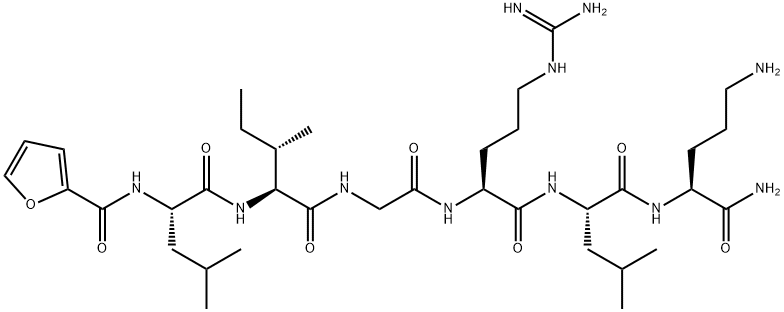Uses
2-Furoyl-LIGRLO-amide trifluoroacetate salt may be used as a protease-activated receptor 2 (PAR2) agonist in endothelial progenitor cells (EPCs) and in transient receptor potential cation channel subfamily V member (TRPV4)-transfected HEK293t cells.
General Description
2-Furoyl-LIGRLO-amide trifluoroacetate salt is a peptide that acts as a proteinase-activated receptor-2 (PAR
2) agonist, and contains a furoyl group addition at its N-terminal.
Biological Activity
potent and selective par2 receptor agonist (pd2 = 7.0). causes a dose-dependent relaxation of murine femoral arteries.
Biochem/physiol Actions
2-Furoyl-LIGRLO-amide is a potent and selective protease-activated receptor 2 (PAR2) agonist. PAR-2 activation is associated with increases in cAMP and intracellular Ca(2+). Immunoblot analysis revealed increases in phosphorylation of epidermal growth factor (EGF) receptor (EGFR) tyrosine kinase, Src, Pyk2, cRaf, and ERK1/2 in response to PAR-2 activation. 2-Furoyl-LIGRLO-amide is nearly 100-fold more potent than SLIGRL-NH2 (Cat. No. S9317). 2-Furoyl-LIGRLO-amide caused both an endothelium-dependent relaxation and an endothelium-independent contraction. It produced delayed (6 hours later) facilitation of capsaicin-evoked visceral nociception, an effect being much more potent than SLIGRL-NH2. Such effects were mimicked by i.col. trypsin. 2-f-LIGRL-NH2, coadministered repeatedly with caerulein six times in total, abolished the caerulein-evoked abdominal hyperalgesia/allodynia in WT, but not PAR2-KO, mice. Repeated doses of 2-f-LIGRL-NH2 moderately attenuated the severity of caerulein-induced pancreatitis in WT animals. It induced a similar dose-dependent increase in Ca2 levels in the presence and absence of b-arrestins.


